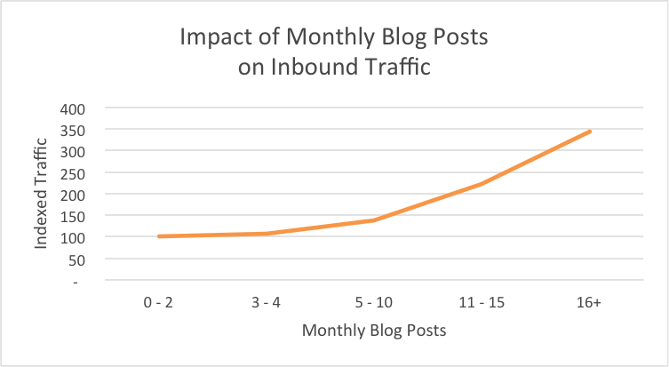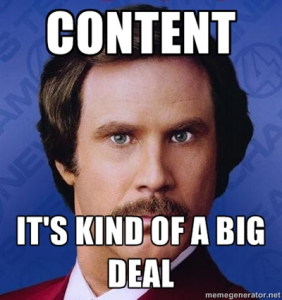Like other buzzwords (yes, I’m talking about words like “dynamic” and “synergy”), the meaning behind “content” sometimes loses its effectiveness in the business world because it gets used so often. And that’s a real shame considering how important content is and how integral it can be to connecting with your customers on a deeper level.
In this article, I’ll explore the various types of content we use to get our clients ranking in the top 3 results in Google and on Page 1, as well as list some considerations for choosing your own preferred content “vehicles.”
But first, let’s nail down what we mean by this all-encompassing term.
What is content?
Defining a term as broad as “content” is more difficult than you might imagine. For starters, the word has multiple meanings in the English language:
- Something that is contained (as in “What are the contents of this article?”)
- Significance or profundity; meaning (as in “That movie lacked content.”)
- Being in a state of peaceful happiness; satisfaction (as in “I’m am very content reading this article.”)
- An affirmative vote or voter in the British House of Lords (not a clue on this one…)
For the purposes of online marketing, however, content is primarily used as noun defined as “substantive information or creative material” and “information and experience(s) directed towards an end-user or audience.”
Another one of my personal favorite definitions is this one:
Think of Web content as the public conversation that happens between you and the visitor, whether the conversation is one-way (from you to the visitor), two-way (between the visitor and you), or conversation among visitors.
But perhaps the simplest definition of content can be expressed as a formula:
content = information
Don’t let that simple equation fool you, though. Trying to utilize the many ways content helps you succeed in your business can sometimes feel like trying to pour a bucket of water into a small bottle – it’s impossible to capture every drop of potential.
Now let’s crack our knuckles and dig into the details…
Top 20 Content Vehicles You Should Be Using to Drive User Engagement
- Establishing trust, credibility and authority in your company’s brand
- Educating, entertaining and inspiring your target audience
- Boosting Google rankings, which draws more traffic (and eyeballs) to your site
The huge umbrella term “content” can be categorized into many different types. Here at SEO Advantage, we like to refer to these many different types of content as “vehicles.” If a content strategy is your map (or road to success), then the content vehicles are how you actually reach your destination. Depending on your business, some content vehicles achieve faster results or perhaps have more streamlined cost.
If you’re anything like me, when defining something it helps to see real-world examples. So here’s a list of the most effective types of content based on our own research, industry data, and general results in the content marketing realm.
1. Whitepapers & Articles
Building a comprehensive library of robust whitepapers and articles on your site is one of the best ways to show visitors (and Google) that you actually know what you’re talking about. This content should be chock full of expert technical information and focus on more permanent topics in order to retain a long “shelf life.”
Whitepapers and articles are longer and more detailed than ordinary blog posts, and often include:
- How-to guides – Step-by-step, process-driven information designed to help your audience do something better; should be specific and to the point.
- Lists – Articles assembled into easy-to-scan bulleted or numbered lists; one of the most effective of all types of content, especially when combined with a “listicle” visual summary.
- Case studies – An explanation of your product or service and how it helped a client/customer; overview of problem to solution.
2. Blog Posts
A business blog is a forum where companies can connect to their customers on a more personal level. A blog post is written content aimed at targeting how-to topics, lists, questions, news, and other types of content. Blog content is typically more conversational, consistent and concise than whitepapers or articles. However, long-form blog posts (like this one) also tend to perform well in terms of sharing and rankings.
The more frequently a business blogs, the greater amounts of traffic they receive – as this Hub Spot study below proves.
By structuring your blog in a certain way, you can enhance its SEO even further in just a few simple steps. Learn how to optimize your blog for visitors and search engines with categories and tags.
Need more convincing? Read: 21 Reasons to Start Your Business Blog
3. Press Releases
When your target audience wants to catch up on the latest news, many head to national and local media outlets. Submitting news releases to these journalists and editors is a great to expand coverage of your brand and potentially earn high value link referrals back to your site, which Google likes a whole a lot.
Wire services – both paid and free – provide a great service to companies by allowing them to submit content that can be instantly sent out to a massive network of media outlets.
Press releases can be written about any kind of company news you wish to share, including:
- Company Growth & Milestones – New site, company name change, reorganizations, new office/location, partnerships and executive changes.
- Products and Pricing – Free shipping offers, new products/services, contests, free sample promotions and product name changes.
- Thought Leadership – New market studies affecting your business, awards won, free educational resources, media appearances and commentary.
- Customer Endorsements – Case studies, customer acquisition milestones, celebrity and public figure endorsements.
- Branding – Rebranding, website upgrade, company name change and product name changes.
- Community Involvement – Participation in a local charity or organization, recent donations, internship programs and volunteer work.
- Corporate/Industry Events – Upcoming seminars, trade show appearances, event sponsorships, etc.
Looking to cut costs? Click here for a list of free press release distribution outlets you can use to share your company’s news with as many outlets and people as possible.
4. Infographics
Content doesn’t always have to be written. Visual content is an invaluable content marketing technique in today’s world.
An infographic presents valuable information or data in way that connects with those in your audience who are more visually oriented. Studies show that infographics almost always get more shares, views, and social media love than other types of content. A well-crafted infographic has all the elements for a viral takeoff.
Infographics can be a powerful communication tool for businesses – if done right. Once you have an idea, recruit a proficient designer or use an infographic service like Visual.ly to make it happen. One tip: keep it simple.
See more tips for creating a beautiful infographic.
 5. Memes
5. Memes
Memes? Yep, you know those hilarious images with text that your employees probably look at to waste time while on the clock? Well they can actually have business value too. Engaging your customers with humor and entertainment is a great strategy for boosting social media sharing with minimal effort.
6. Images
Continuing right along with the theme of visual content, embedding stock images or photography into your written content can add tremendous value to your blogs and articles. According to Jeff Bullas, articles with images get 94% more total views than articles without images. (He even includes a cool infographic to show this data. Bonus points Jeff!)
Custom images are better for making your company look even more personable, but stock images perform well too. Check out this post for a list of free and low-cost stock image sites we recommend.
7. Data Visualizations & Illustrations
While creating custom charts, graphics and illustrations is a major investment of time, companies that can afford to spend are able to reap serious rewards by doing so. Illustrations create visual interest that makes your written content appear unique and outstanding.
8. Videos
It’s estimated that as much as 80 percent of millennials watch a video before making a purchase decision. With whopping statistics like that, how can you not at least consider the potential power of video in your content marketing strategy? YouTube and other online platforms make it easier than ever to upload or embed videos onto your site.
When done well, videos can impart your message in a highly memorable and persuasive way. This is an ideal platform for an office tour, interviews, how-to tutorials, or maybe even a viral music video.
9. Testimonials
Who says you have to do all of the talking when it comes to content production? Highlighting endorsements from satisfied customers gives your business major social proof points and can be a powerful marketing tool.
Testimonials and reviews are similar to case studies, except that they are told directly from the customer’s perspective using their own words.
Check out our tips on using testimonials.
10. Syndicate Posting
By publishing top-notch content on your site, content library and blog, you open up opportunities to get republished on other popular industry sites. Many sites will gladly accept your content if it is professional and well-written. This helps expand your potential audience greatly. In many cases, all you have to do is simply reach out and ask site admins about their policies/procedures on content syndication.
Of course, you don’t want to content linking to your site from a cheap syndication service. The quality of the link is also important, so you should choose wisely. For more information, read: Who is Linking to Your Web Site – and What Does that Say about You to Google?
11. Q&A’s (and FAQs)
When your audience has questions, are you providing a platform for them to find answers? If you don’t, another company will. We recommend creating a hub for Frequently Asked Questions (FAQs) concerning the most common queries you receive about your products or services. These technical pages are often a rich source of keyword optimized content for search engines as well.
See our Q&A section for an example of what a FAQ section looks like.
12. Product Descriptions
If you manage an e-commerce site, consider taking a second look at your product descriptions. While you may be tempted to create standard, bland descriptions in order to make your product available as fast as possible, writing unique product descriptions, though more initial effort, pays off the end.
13. Roundups
Link pages, or link “roundups,” are the ideal type of content for marketers with minimal time on their hands. To create a roundup, browse the internet for top trending topics which are effecting your industry, then create a list (inserting your own unique spin and commentary) featuring these important stories for your customers. Not only are you benefiting your audience by saving them from having to do the research themselves – you’re also enhancing the link portfolio of your site and opening up further opportunities for content syndication and guest posting.
14. Ebooks
As one of the longest forms of content, ebooks should be intended for your most involved customers who are eager to learn more about your brand, products and story. Packaging the best samples of your articles and other writing into one comprehensive guide helps strengthen your industry authority and provide a powerful platform for sharing more detailed knowledge about the topics that most matter to your customers.
To reap the greatest rewards from your ebook, consider making it a free downloadable PDF resource and posting it on your home page. (Bonus tip: Write a press release announcing your ebook too!)
15. Templates & Downloadable Resources
In addition to ebooks, downloadable resources and templates aimed at providing a high value service to your audience can go a long way towards establishing credibility. Offering free downloads of guides, worksheets and checklists in exchange for email addresses can also help you build your email list by offering the visitor some incentive.
16. Landing Pages
When done right, landing pages are one of the best types of content in terms of conversion rates. Think of a landing page as an alternate home page which targets a specific product or service you offer. The copy on your home page is typically more general in nature and about the company as a whole, so landing page content is where you can really hone in on certain keywords and phrases that get you to rank in Google. Landing pages can be written for pay-per-click campaigns or about various sections of your business you wish to target.
17. Surveys & Quizzes
Surveys and quizzes give you an insight into what your audience needs and how you can deliver it to them. Data acquired from customer surveys or polls is very useful in researching how to create more targeted content.
18. Guest Posts
Just as content syndication can help expand your blog’s audience, sharing your expertise by guest posting on other industry sites is a fantastic way to grow your online presence and earn high-value links back to your site. Many types of content are good for “guesting,” including blog posts, podcasts, videos, articles, webinars, etc.
19. Comments
Enabling comments on your blog is a great method for more effectively communicating with your audience and others in your industry. Comment boxes allow customers to ask questions, give you marketing insights, provide an additional platform for sharing information, and even obtain organic links.
20. Social Media
Of course, our list of important content types wouldn’t be complete without discussing one of the most effective forms of content marketing these days: social media. More and more people are gathering their information and news from social media platforms. According to Pew, nearly half of U.S. adults get news via Facebook.
Whichever social networks your audience is using, you should be there to connect with them. Top social media sites include:
- Google+
Additional reading: Utilize Social Media to Gain Additional Exposure for your Website’s Content
Choosing the Best Content Type
In an ideal world, a business could spend all the necessary resources to create a diverse inventory of content that targets all facets of their customer base. However, there are hundreds of different types of content out there and few organizations are able to invest the extensive time and resources it would require to do them all.
Therefore, you must make a decision – Which types of content are best for my business?
Here are 4 tips to keep in mind when choosing the best content vehicles for your organization:
- Start small. Just like there are often several routes to get to the same destination, there are various content marketing strategies that can help you achieve the results you desire. Since you can’t do them all, we recommend scheduling one or two types of content and analyzing their performance, then going from there.
- Eliminate the unsuitables. Certain types of content may not be suitable for your brand. If not, no worries. Eliminate them from the list. Content marketing success isn’t about trying every type of content out there – it’s about finding the most effective content vehicles for your unique needs and audience.
- Be bold. Are you afraid of trying new types of content because they might not work? Don’t be. Trial and error is a necessary part of the content marketing process. Start simple and work your way up. Above all, don’t let fear of failure stop you from trying new things.
- Get creative. Last but never least, get those creative juices flowing and invent a brand new type of content for your organization This list is not comprehensive and there are plenty of other ideas out there yet to be attempted. Be a thought-leader and try new things!
As you can tell, there are lots of options when it comes to content. The most important takeaway is that content, in whatever form, should speak to your audience on a personal level. Accomplishing effective communication with your customers will help boost your brand authority and result in more visitors, shares, likes, learns, and ultimately, conversions.
How do you define “content”? What are your favorite types of content work?
Let us know in the comments below or on Facebook.



 5. Memes
5. Memes
lanceSEOA says
Thanks Lisa! That’s definitely an important distinction there. 😉
Lisa Banks says
Love the post, Lance! Especially how you tied “effective” content to ROI in the takeaway box.